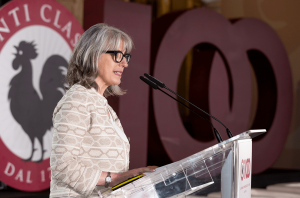Director of the Chianti Classico consorzio, Carlotta Gori announced a new sustainability manifesto in Florence during the consorzio’s 100th anniversary celebrations.
The Chianti Classico consorzio – the oldest wine consortium in Italy – marked its centenary in Florence last week with a programme of events. Founded in 1924 with 33 original members, the consorzio has expanded to comprise 500 wineries over the last 100 years.
During a conference, representatives from Italy, France, Portugal and the USA each presented sustainability and regional identity initiatives which are being carried out in their respective regions – all of which built up to the big news of the day.
Chianti Classico’s sustainability manifesto
‘Over the last few months, we’ve been considering how best to celebrate this centenary, this extraordinary milestone,’ said director of the Chianti Classico consorzio, Carlotta Gori as she introduced a new sustainability manifesto.
‘We immediately decided we should look ahead, and from today onwards would foster a vision. Not daring to match our founding fathers but at least with a similar approach – planning for the future while simultaneously safeguarding the land and all it produces.’
The new sustainability manifesto has two key objectives: to reduce the environmental impact of winemaking throughout the supply chain, and to enhance growth and development of what Gori described as ‘social and cultural resources’.
In total there are 57 guidelines, and producers are expected to adhere to at least half of them. ‘It’s ambitious,’ she admitted.
Guidelines aimed at cutting down on environmental impact include wineries keeping 20% of their surface area ‘wild’ to promote biodiversity; no chemical herbicides or fertilisers; and using bottles made from at least 50% recycled glass. Gori pointed out that 62% of the Chianti Classico area is woodland, while 52% of the vineyard surface is farmed organically, with more currently undergoing conversion.
At the heart of the cultural aspect is the area’s estate-villa structure, which has been put forward for consideration as a UNESCO world heritage site. There are 341 protected historical sites in Chianti Classico, with more than 150 estate-villas.
‘The Tuscan landscape is one of a kind – churches, villas, castles, farms – based on harmony and integration,’ said Piero Antinori during a roundtable discussion following Gori’s announcement.
There is also a social sustainability aspect to the manifesto which ensures, for example, that at least 20% of workers employed live in the surrounding area, and that disadvantaged and under-represented groups are included in the workplace at above-minimum legal levels.
The long history of Chianti Classico, in brief
While 100 years is an impressive anniversary, the history of Chianti Classico stretches back much further, with the term ‘Chianti’ in relation to wine found in a document dating back to 1398.
The spectacular Palazzo Vecchio, which hosted part of the day’s programme, features the symbology of the black rooster of Chianti – today the emblem of Chianti Classico DOCG – in one of the Salone de’ Cinquecento’s 42 ceiling panels, painted in 1565 by Giorgio Vasari under the patronage of the Medicis.
In 1716, Grand Duke of Tuscany Cosimo III legally defined the boundaries of the Chianti area.
In 1872, Barone Bettone Ricasoli developed the first Chianti ’recipe’: Sangiovese for aroma, Canaiolo for sweetness, and Malvasia to lighten the blend for everyday drinking.
In 1932, the term ‘Classico’ began to be used to recognise wines made within the original territory defined by Cosimo III.
In 1967, Chianti was recognised as a DOC, and Chianti Classico became an official subzone.
In 1984, Chianti and its subzones were elevated to DOCG, and in 1996 Chianti Classico was recognised as a separate DOCG.
In 2014, the new Gran Selezione category was introduced for Chianti Classico.
Recognition of long service
A gala dinner in the evening saw some delicious wines being poured, from vibrant, youthful annata to older vintages of Riserva and Gran Selezione. Before a birthday cake was brought out, complete with sparklers, the founding wineries of the consorzio were each invited to the stage to receive an honorary award.
Francesco Ricasoli, pictured below, whose ancestor, Bettino Ricasoli formulised the Chianti ‘recipe’ in the 1870s, toasted to ‘another thousand years’ when he collected his award.
Francesco Ricasoli of Barone Ricasoli – one of the founding members of the consorzio – receives an award from president of the consorzio, Giovanni Manetti.
Related articles
City guide to Florence
A drink with… Alessandro Masnaghetti
Decanter’s Dream Destination: Borgo San Vincenzo, Tuscany, Italy
The post Chianti Classico consorzio’s 100th anniversary marks sustainable future appeared first on Decanter.
